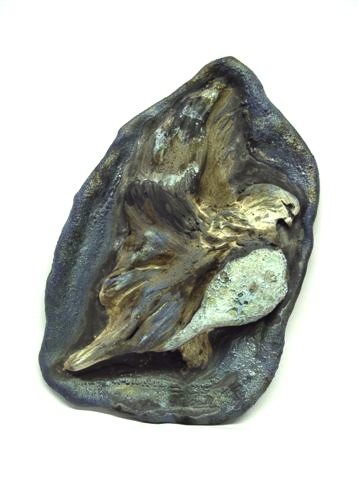|
My clay studio is currently closed due to construction. Check back in 2014.
For centuries we have cremated the remains of our deceased. In many cultures these ashes, (cremains) are kept in containers (funerary urns) in the descendants' homes
to honor the memory of the one who has passed. A more modern concept is to put the ashes into a glaze on a piece of
ceramic art and then spread the remaining ashes at a place of spiritual significance to the family.
| Funerary Vessel 2007 in private collection |
|
|
| Raku Urn 12" |
I find and channel the energetic flow of the deceased into my hands while creating the ceramic piece. I also use wood ash and those gathered from a building to honor the passing of a tree, home or era.
| Raku Funerary Sculpture 10" |
|
|
| collection of the Bennett Family |
I make funerary pieces in my own style; vessel, altar, sculpture or wall mounted
visual. I create a piece of durable art that is completely handmade and original.
Lids, if desired on the pieces, can be made from wood, glass, metal or polymer as well as clay.
I am an established, collectible ceramic artist and have experimented with glaze
formulation since 1974. Once I have used the cremation ashes in the glaze, the funerary art becomes a totally
unique creation that can never again be exactly duplicated.

|
| Raku BasRelief Pigeon 12" Collection of the Bennett Family |
| Stoneware Urn 9" Sample Classic Lidded Vessel |
|
|
| donated to Harvest Auction Todd Mission TX |
DURABILITY: I purposely make these pieces
thicker than most utilitarian pieces, and heavy on the bottom so that they are less likely to fall over if bumped. I prefer
to use stoneware for memorial ceramics because it is more durable but I can make raku as well. These pieces
are not intended to be used in outdoor conditions or placed in the dishwasher, microwave or oven. I will not
apply these bone ash glazes to ware that is intended to contact foods, i.e. platters, bowls and mugs. These are not intended to be utilitarian glazes and are not food safe. If you choose a container, the lid
can be sealed to the urn, if desired, with clear silicone. It can be cut with a blade if access to the ashes is
required later on.
ASHES: I need only about two tablespoons
of sifted ashes to add to the other chemicals that I use to glaze one 8-10 inch tall urn.
Call or email to discuss this.
LEGAL: The ashes must be sent to me by
a family member or legal custodian who has accepted them from the funeral home or crematorium. This is the legal structure in most states. I suggest that the ashes are sent to me by first
class mail, double wrapped in two layers of plastic zipper bags and then in a padded envelope or box. So far that
has not caused any problem in shipping.
It is up to the purchaser of the art
to research the laws of the resident's state as far as shipping the ashes to me. I will assist as well as I can with information.
Most states have a funeral board which will provide needed information. I cannot assume any legal responsibility
for the laws governing the shipment of the ashes or for notifying anyone concerned.
To accommodate very large family orders
of many pieces of art, where the usual 100-300 cubic inches of cremains is not enough to produce enough glaze to cover
numerous pieces, I can decorate areas of the vessels or altars with the special ash glaze, and can use some of my stock glazes
to coat the inside and other areas of containers as needed. This allows each member of an extended large family to own a piece
glazed with the cremains of the deceased. Any leftover ashes not used in the production of the pieces will, of course, be
returned to the customer.
SERENDIPITY: Although I test the ash
glaze for adherence, I cannot 100% guarantee the exact color or texture of the finished piece.
There will often be particles in the glaze that will give the surface nubby or bubbly effects and it won't be uniform. I
can't know, for sure, what effect the individual's spiritual or chemical makeup will have on the final glaze until I pull
it out of the kiln. Bone ash is generally an opacifier, but other items in the cremation, such as fabrics, leather, metal
jewelry and plastics, all add to the unique chemistry.
It is impossible to make certain that
an exact color will appear from those ashes in that particular kiln environment.
Since these are not mass produced items
from a mold, there will definitely be some variation of the shapes and size as well! With all these variables you will end
up with an exclusive piece of art that can never be exactly reproduced.
| Raku Funerary Vessel |
|
|
| private collection |
Candle and incense holders are designed to be fireproof but one should NEVER leave
a flame unattended.
I can also combine non-ash glazes with these on various areas of the piece
if there is a special color you desire, and I have a blue glaze that has changed color each time I have used it with different
ashes.
|

